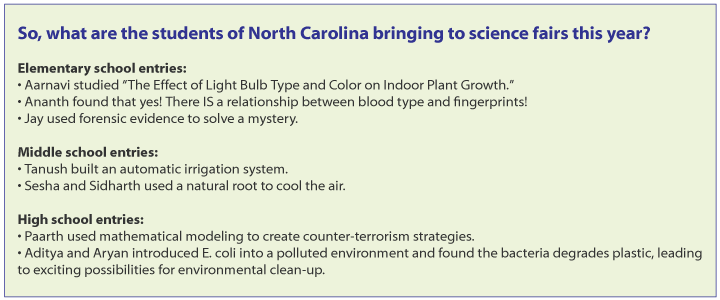Science fairs have come a long way from the vinegar and baking soda volcanoes, and the North Carolina Science and Engineering Fair (NCSEF) is ensuring that students from all over the state and across grade levels are getting a real chance to shine.
The NCSEF provides the opportunity for students in 3rd through 12th grades interested in STEM fields to research the topic of their choice and present their work at a public competition with their fellow students. Kids come from all over the state, including from traditionally under-represented areas. Each year, the fair conducts thorough demographics research so that students from these areas can be reached through robust teacher workshops, outreach, and more targeted grant writing strategies.
When asked how science fairs stay relevant and fun, NCSEF’s Executive Director Theresa Gibson says, “Inquiry and design are the backbone of how professional scientists and engineers work every day in their careers. Supporting this inquiry and design with our K-12 kids, we’re giving them an opportunity for excellence and supporting to share their creations just as real scientists and engineers do. We’re bridging the gap between STEM education and STEM careers.”
Indeed, many of the elements to building a successful career in STEM are rooted in the very benefits that science fairs provide:
- Increased organizational and process skills
- Strengthened writing and communication skills
- Creativity and outside-the-box thinking
- Improved visual/spatial thinking and innovative problem-solving
- Curiosity
Gibson also notes that while the fairs themselves are fun and enriching, so much of what NCSEF does continues to reach students long before (and after) the fairs are held. For example, the teacher-facing support they offer are designed to support student-led research through scientific inquiry and engineering design in all STEM instruction.
Supporting instruction that incorporates critical thinking; math analysis of data, graphs, and charts; computer skills; interpretation of scientific data; and a general increase in scientific literacy. The ultimate goal is to support students’ intellectual curiosity and breadth of scientific skills to prepare them for the STEM careers of the future. Further, NCSEF introduces students to professionals in STEM fields so they can ask questions, engage personally, and see in person what working in research, science, engineering, and mathematics means in real life.

Ana Ratanaphruks never fancied herself a scientist or particularly good at math. She liked crafts and cooking, but at the urging of her science teacher, she competed in her first fair in 8th grade with an experiment about different types of olive oil. And she was hooked! Today, she is a graduate of Wake STEM Early College and will pursue engineering in college. She says that science fairs had a deep impact on her life, she made lots of friends, got a chance to dazzle judges and professionals in the industry, and found her passion in STEM (which, she admits now “isn’t just about robots and microscopes”). She dreams of someday helping to bring STEM resources to rural communities and other kids who don’t currently have the experience and resources that she is so grateful to have had.

For more information about NCSEF, competing in a science fair, obtaining teachers’ resources, or volunteering, visit http://ncsef.org.
While the original link implies this is about broadband, it is really about the wonderful NC Science and Engineering Fair led by Theresa Gibson and supported by the NCTEF, led by Tom Williams. Great work!
Charles